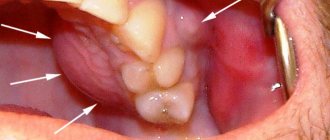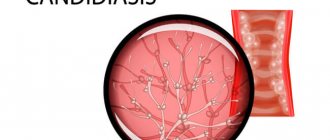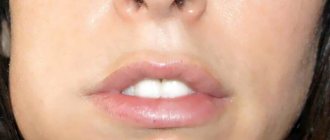Flux on the gums is an extremely unpleasant, but quite common phenomenon, which is an inflammatory process in the periosteum area. The word “flux” is of German origin and is translated as “flow, flow.” Today, this term is not commonly used in professional circles. Instead, experts use the scientific name of the disease - odontogenic periostitis. In most cases, it overtakes the most patient patients who diligently avoid visiting a professional dentist for a long time. As a result, due to laziness or fear of the dentist, the patient receives severe swelling of the gums, constant dull pain, and in some cases, high fever.
Despite the fact that the phenomenon in question cannot be called a rarity, this does not make it any less harmless. The advanced form of periostitis is quite dangerous, so the health of the oral cavity and teeth should be taken as seriously as possible, and at the first signs of inflammation you should consult a specialist as soon as possible.
Causes of the disease
Patients often blame the careless work of dentists for the development of inflammatory processes in the oral cavity. Thus, “flux after wisdom tooth removal” is one of the most discussed topics on dental forums. In fact, the most common causes of periostitis are gum trauma and untreated tooth decay. Often the situation is complicated by the patient’s reluctance to visit the dentist in a timely manner. As a result, food debris inevitably accumulates in places of damage, which eventually begin to rot. Further, the pus accumulates and then begins to rapidly spread, affecting healthy tissues of the oral cavity.
The most common causes of gumboil are damage to the gums, poor oral hygiene and caries.
Treatment of flux on the gums with folk remedies cannot guarantee a high-quality result. Most often, self-prepared medicinal products can only suppress the pronounced manifestations of the disease, and not eliminate the causes of its occurrence. For this reason, when the first symptoms of periostitis appear, it is important to undergo high-quality flux treatment in dentistry, which can guarantee complete relief of the inflammatory process.
General indications for tooth extraction in children
The child’s dentition is formed according to certain patterns: the incisors erupt first, followed by the molars. Then the baby teeth are gradually replaced by permanent teeth. If this process occurs correctly, without deviations from the norm, there is no need to specifically remove baby teeth. However, there are situations when this is necessary:
- advanced caries;
- the last stage of development of a cyst on the gum;
- severe tooth injury;
- a tooth that fails to develop and erupt.
Removing a child’s front tooth is a particularly unpleasant procedure, as the aesthetics of the smile suffers. Usually, surgery is resorted to in the following circumstances:
- exposure of the pulp due to a fracture of the coronal part;
- severe tooth decay with the impossibility of prosthetics;
- inflammatory diseases that cannot be treated.
Most often, children have to part with their teeth in the chewing area. Molars are more susceptible to destruction than premolars and incisors. Removing a child's molars, which are the last in the dentition, is complicated by their inaccessibility and strength: they fit quite tightly to the gums, have wide roots and massive walls.
Sometimes children develop an anomaly such as an extra tooth, which can move the “neighbors” and lead to curvature of the entire row. If it does not interfere with the normal formation of the remaining teeth, you can leave it and try to integrate it into the bite, but most often they resort to removing the supernumerary tooth in the child.
The factors described above are the general and most common indications. Let us consider separately the reasons for the removal of baby and permanent teeth.
Symptoms of gumboil
Symptoms are expressed in the appearance of a purulent sac or thickening of the gum area. The photo shows a clear example of gumboil on the gum. It is this infiltrate that is the main sign of the development of the disease. Experts distinguish two main forms of periostitis:
- The acute form is accompanied by severe toothache, severe tissue swelling, and swelling of the cheek. As the disease develops in the lower jaw, inflammation of the lymph nodes and swelling of the chin may occur. Often the advanced form of the disease causes elevated body temperature.
- The chronic form of the disease proceeds slowly and imperceptibly, which is its insidiousness. Often there is thickening of the jaw bone in the affected area. Despite the fact that there are practically no pronounced symptoms in this case, the consequences of this form of flux are no less dangerous.
What is flux
Flux is a somewhat outdated name that is common only in everyday communication. In modern dentistry, this pathology is called periostitis, which reflects the essence of the disease.
Periostitis is a purulent inflammation of the periosteum that covers the bone of the upper or lower jaw. As the pathological process develops, the lesion ceases to be local in nature and spreads to other tissues - an abscess appears on the surface of the gum.
Diagnostics
Before proceeding with dental flux treatment, the doctor must conduct an appropriate diagnostic examination. The exact diagnosis is determined based on data obtained during a clinical examination and x-ray diagnosis. Laboratory tests allow you to accurately determine the stage of the inflammatory process. Only after making an accurate diagnosis will a specialist be able to decide what to do with gumboil and which method of treatment in this particular case will be optimal.
Wisdom tooth removal
Typically, wisdom teeth appear at the age of 20 or older, but in some cases it is recommended to remove their buds. There are the following reasons for the removal of wisdom teeth in children:
- displacement of the follicle of the third molar;
- prerequisites for malocclusion;
- lack of space for wisdom teeth.
A specialist can recommend removal of a child’s wisdom teeth only after a thorough examination and consultation with other specialized doctors. You must first determine what position the molar is in and what place it will later occupy in the jaw.
How to treat flux?
If your tooth hurts and gumboil appears on your cheek, you shouldn’t panic and look for something to rinse your mouth with. “Grandmother’s” treatment methods really help get rid of acute pain and relieve some swelling, but they have not yet helped anyone cope with purulent compaction, which is the main danger. How and with what to treat flux? How to remove gumboil in case of gum inflammation? Only a qualified dentist can give detailed answers to these and other questions.
Self-medication with folk remedies will only help dull the pain and relieve swelling a little. Only a qualified dentist can completely remove pus and eliminate the cause of inflammation.
How is flux treated in dentistry? Currently, there are two main methods of treating gumboil on the cheek:
- Opening the pus sac, in which the doctor removes the accumulated pus through a small incision. The procedure is performed under anesthesia. After removing the pus, the specialist installs a drainage at the site of the incision - a special rubber strip that ensures the outflow of pus and prevents the wound from healing ahead of time.
- Cleaning an abscess through a root canal is necessary if the inflammation is a consequence of caries or a crack in the tooth.
Often in advanced stages of the disease there is a need for tooth extraction. Typically, this procedure is carried out when there is deep destruction of the causative tooth or if there is a large infected area between the tooth and the gum. Removal is also used if there is a sufficiently large crack in the tooth that cannot be treated.
Typically, the doctor begins by making an incision into the periosteum or lining of the mouth. The causative tooth is usually removed gradually, that is, in parts. For this, a special dental saw or laser is used. Modern equipment has made it possible to make the procedure for tooth extraction quick and completely painless, so there is no need to be afraid of treatment. After the operation, the sharp edges of the incision are smoothed, which is then washed with peroxide or other antiseptic agents and fixed with sutures.
Possible complications
Very often, parents underestimate the seriousness of such a disease as gumboil in children. However, this pathology is fraught with extremely serious complications that can even threaten the baby’s life.
- An abscess is the formation of a large purulent focus, the boundaries of which extend beyond the periosteum. Sometimes such ulcers can break out in the gum or even cheek area, forming fistulas from which pus constantly flows.
- Cellulitis is the spread of purulent inflammation to adjacent anatomical areas. The most severe consequence of flux, in which there is a very high risk of developing sepsis - blood poisoning, often leading to death.
- Death of the rudiments of permanent teeth, leading to adentia. Severe inflammation within the gums can spread to the area of the permanent tooth bud and cause damage or death. As a result, when changing the primary dentition, the eruption of molars will not occur, which will require prosthetics at a young age.
It is not difficult to suspect the development of complications. Usually, with treatment after opening the flux, the symptoms quickly begin to subside. After a few hours, the child’s temperature decreases, swelling decreases, and the incision site practically does not hurt. But if the fever does not go away, and the pain only increases, then this is a reason to seek emergency medical help again, because Most likely there are inflammatory complications.
Antibiotics for flux
As noted above, flux is a consequence of a bacterial infection, which is often treated by taking antibiotics. Many, at their own peril and risk, try to cope with inflammation by independently taking quite strong medications that can cause serious damage to the health of the entire body. Effective and at the same time safe treatment of flux with antibiotics can only be prescribed by a qualified specialist.
Antibiotics for flux are prescribed by a doctor individually. Self-use of strong medications is fraught with serious consequences for the entire body.
Antibiotics, like anti-inflammatory drugs, are used in dentistry for flux as part of complex maintenance therapy. The only way to stop the inflammatory process and remove the pus is surgery. Antibiotics are usually prescribed at the very beginning of treatment if the disease is in the earliest stages of its development, but identifying such inflammation at the initial stage can be quite difficult. As a rule, the dentist is able to detect the very first signs of periostitis by accident, for example, during a routine examination of the oral cavity. The specialist prescribes antibiotics for flux individually, depending on the characteristics of the patient’s body and the general clinical picture.
Treatment
Treatment of flux in children should be carried out strictly under the supervision of a doctor. At the same time, treatment tactics for a one-year-old baby and a 7-year-old child may differ due to the fact that before the natural change of the primary bite, it is possible to remove a temporary tooth, which is extremely undesirable before the age of 5-6 years.
In such cases, it is rarely possible to do without surgery. Quite often it is necessary to resort to a surgical method of treatment - opening the flux with complete removal of all purulent masses and drainage of the resulting cavity. This allows you to both relieve acute pain and prevent the re-formation of gumboil.
But surgical treatment is one of the stages of therapy. After visiting the dentist, the child’s parents should continue treatment at home, which will include taking an antibiotic prescribed by a doctor, rinsing the mouth with antiseptic solutions and using traditional medicine.
Treatment at home
In the first few days after visiting the dentist, when pain may still bother the baby, it is necessary to take anti-inflammatory drugs (paracetamol, ibufen), which help both relieve pain and help the inflammatory process subside as quickly as possible.
An important point in home treatment is the use of antiseptic solutions for treating the oral cavity. The dentist will tell you what exactly to rinse the child’s mouth with, but we will only present possible treatment options that can be used even in a small child.
- Aqueous solution of chlorhexidine. A ready-made pharmaceutical preparation is used, which is used to rinse the mouth 3-4 times a day (after meals and before bedtime). It has a powerful antiseptic effect, but does not irritate the mucous membranes of the mouth.
- Furacillin solution. You can prepare it at home (1 tablet per 0.5 liters of water) or buy a ready-made product. Rinse your mouth up to 5 times a day (it is advisable to do this after eating).
- Miramistin is destructive to microorganisms and relieves inflammation well. It is recommended to rinse your mouth with 10 ml of solution 3-4 times a day. However, the drug cannot be used before the age of three.
A child should rinse his mouth with any of the above products strictly under the supervision of adults in order to avoid accidents. The course of treatment should continue until all manifestations completely subside and the purulent cavity heals.
Treatment with folk remedies
Traditional medicine recipes complement traditional treatment well. However, you need to be careful with such methods in very young children, and for treating children under 2 years of age it is better not to use them at all.
- Soda solution. This remedy has a good anti-inflammatory effect. A teaspoon of dry baking soda powder is dissolved in a large cup of warm boiled water and allowed to rinse the child’s mouth 3-4 times a day after eating. The effect of treatment can be enhanced with iodine by adding a few drops to the rinse solution.
- Propolis tincture also perfectly relieves inflammation and has an antiseptic effect. To treat the oral cavity, dissolve 5 drops of tincture in 200 ml of warm water and rinse the mouth 2-3 times a day.
- Herbal decoctions. Medicinal plants such as chamomile, calendula, and string are natural antiseptics and quickly relieve even severe inflammation. They allow both to cure the disease itself and to prevent the development of its complications. Decoctions are prepared daily, for which 2 tablespoons of a mixture of herbs are infused in half a liter of boiling water. Rinse your mouth with the resulting decoctions 4-5 times a day until complete recovery.
Homeopathy treatment
Homeopathic medicines can also be used in addition to primary treatment. You cannot try to cure gumboil in a child using homeopathy alone, since such remedies only play a supporting role. All prescriptions should be made only by a homeopathic doctor.
Flux - treatment in children
If a child has flux, you should never give him medications on your own, and especially antibiotics. Only a dentist can prescribe a medicinal course of treatment. Antibiotics destroy both pathogenic and beneficial bacteria that help fight infection, so the unauthorized use of such serious drugs can lead to negative consequences for the child’s entire body.
Treatment of gumboil largely depends on the causes of its occurrence. So, this process is not much different from the treatment of periostitis in adult patients. As a rule, to begin with, the specialist makes a small incision in the area of the inflammation and ensures the outflow of pus using a special drainage system. The treatment then continues at home under the supervision of parents. Most often, a complex of medications is prescribed, but in some cases, a specialist may allow you to limit yourself to rinsing with special decoctions and solutions.
Treatment of flux in a child at the CIS
At the Center of Israeli Dentistry on the Left Bank of Kyiv, a team of pediatric dentists performs the full range of treatment measures for diseases of the teeth, gums and oral cavity. We have a special approach to small patients that allows us to get rid of fears and anxiety before medical procedures.
When treating flux in a child, the first thing the doctor does is diagnose it. This includes an examination of the oral cavity, interviews with parents and the child, and an x-ray examination. An x-ray shows the extent of damage to teeth and tissues. Only after diagnostic procedures does the doctor decide on the patient’s treatment tactics.
Flux on the gums: surgical treatment
Flux in children and adults is mainly treated surgically, like all purulent formations. The abscess needs to be opened and the wound cleaned. Surgical operation to remove flux consists of the following steps:
- Pain relief . First of all, the doctor administers local anesthesia so that the child does not feel pain or discomfort.
- Removing flux . After administering the anesthetic, an incision is made with a scalpel. The doctor removes the pus, after which a drainage is placed - a small rubber strip. This is necessary so that the wound does not heal prematurely, since within 3-4 days the remains of purulent masses still flow out of the wound.
- Tooth extraction . Typically, teeth in the area of purulent lesions should be removed. Removal of teeth due to gumboil is practiced more often in pediatric dentistry, since children's milk teeth will be replaced by permanent teeth. In some cases, the doctor decides to save a baby tooth if this will have a positive effect on the formation of the child’s bite.
Flux on a child’s gums: what to do after surgery
Therapeutic measures for flux are not limited to surgical intervention. No less important is the postoperative period, during which the small patient is prescribed antibiotics and antiseptics for rinsing the mouth. Even if the child feels well, be sure to take the prescribed medications, adhering to the dosage and regimen.
These treatment measures usually end successfully. Symptoms that bother a child with flux disappear (fever, pain). Within a few weeks, the lump also resolves, since there is no longer an abscess in it.
How not to cause harm?
What to do if flux appears? Some patients mistakenly believe that swelling and severe toothache can be relieved on their own with the help of warming compresses, herbal infusions and other folk remedies. Unfortunately, such health experiments often end very badly. Thus, in order not to inadvertently harm yourself and provoke further development of the disease, the following contraindications should be observed:
- No warming compresses that contribute to the spread of periostitis.
- Never take painkillers less than 3 hours before visiting the dentist. Otherwise, you can significantly complicate the diagnosis process.
- After opening a purulent lesion, you should not take aspirin. It can provoke bleeding, especially since it is completely useless as a pain reliever in this case.
- If your condition has not improved 12 hours after surgery, you should see your doctor again.
Removal of permanent teeth
Removal of a permanent tooth in a child is carried out only in the following situations:
- Caries.
If the doctor sees that a decayed tooth cannot be treated, most likely he will suggest removing it. - Fracture.
A tooth fragment can injure the mucous membrane; it can either be restored or removed. - Crowding.
When installing braces or plates, it is sometimes necessary to remove one tooth to allow others to develop freely. - Complications after treatment.
Sometimes, after poor-quality dental procedures, problems arise that can only be solved by getting rid of the tooth.
What to do after removal or opening?
After opening the flux, you should not wait for the swelling to disappear immediately. Many patients feel that the flux does not go away after tooth extraction, although this is not the case at all. In some cases, the swelling may increase slightly after the procedure. Approximately on the third day after surgery, the patient should make a dramatic recovery, but the infiltration may remain for quite a long time. Within a few hours after the operation, the toothache in the area of the lesion should disappear and the body temperature should decrease.
Usually the swelling goes away only a few days after opening the purulent focus. Do not be alarmed if the swelling increases slightly after surgery.
The specialist installs a special rubber drainage in the incision, which you should never try to fix yourself. Otherwise, the recommendations are the same as for regular tooth extraction. You should not eat for several hours after the procedure. During the day, try to avoid hard and rough foods, as well as hot drinks. Regarding the use of medications in each individual case, the specialist gives individual recommendations.
How to recognize flux in a child
Flux is a lump that often appears on the gum. In most cases, the abscess comes out on the front of the jaw, since the bone wall in this area is thinned, and there is also a significant number of blood and lymphatic vessels there. Sometimes flux appears on the palate.
Symptoms accompanying flux include:
- the appearance of an abscess on the gum;
- aching pain in the affected area;
- swelling of the cheek (it noticeably increases in size);
- increased body temperature;
- enlargement of lymph nodes located near the inflammatory process.
Young children who cannot yet talk (or talk about their symptoms) experience restlessness, tearfulness, and decreased appetite. Carefully examine your baby's mouth. It is quite possible that the cause is gumboil gumboil, which requires medical intervention.
Treatment prices
The cost of flux treatment largely depends on the severity and severity of the disease, as well as on the method of therapy chosen by the specialist. It is worth noting that modern medicine offers all the possibilities for quick, effective and completely painless elimination of the causes and consequences of periostitis. In addition, the price for flux treatment is influenced by factors such as the level of prestige of the dental clinic, the cost of the equipment and materials used, and the level of qualifications of the practitioners.
How much does tooth extraction cost?
Many people believe that the cost of the procedure for adults is much higher than for children, and the price for removing a baby tooth in children is lower than for extracting a permanent tooth. This is not entirely true. The amount of payment for the pediatric dentist depends on the complexity of the case, and the cost of removing temporary and permanent teeth is determined by the indications and concomitant diseases. In the table below, we have listed the main problems with which people turn to a pediatric dentist and the prices for tooth extraction for children.
| Service | Price |
Consultation | from 500 rubles |
Removing a baby tooth | from 1,100 rubles |
Removal of a permanent single-root tooth | from 1,200 rubles |
Removal of a permanent multi-rooted tooth | from 3,000 rubles |
Complex tooth extraction | from 4,000 rubles |
Wisdom tooth removal | from 3,000 rubles |
Removal of a supernumerary tooth | from 1,200 rubles |
Application anesthesia | from 250 rubles |
Local anesthesia | from 500 rubles |
Sedation | from 1,500 rubles |
General anesthesia for 30 minutes | from 4,000 rubles |
General anesthesia for 60 minutes | from 10,000 rubles |
General anesthesia for more than an hour | from 12,000 rubles |
How to prepare a child for tooth extraction
If tooth extraction is unavoidable, try your best to minimize the child’s stress. For example, tell him a fairy tale about how one tooth began to behave badly and interfere with the others, so it needs to be “pulled out.” Before going to the clinic, you can also discuss some pleasant event with your child, be it going to the movies, the circus, or buying a toy, which you will do immediately after removing a capricious tooth. The main thing is not to panic, and then the confident and calm attitude of the parents will certainly give the child the strength to courageously endure this frightening but necessary procedure.
You can avoid tooth extraction surgery in children if you carefully monitor the condition of the oral cavity throughout the entire period of dentition formation, monitor the quality of hygienic procedures and regularly take children to preventive appointments with the dentist.









